Last Friday, social media guru Mari Smith offered a free webinar that took a deep dive through the Facebook changes, and how they work for both individuals and brands. You can download the slides here and listen to the recording here. The webinar was 90 minutes and she took us through step-by-step about how the new features work. At times it was confusing, complicated, and overwhelming, but I came away a couple of ways to think about the changes in terms of privacy. Also, a few insights about the what the changes mean for Facebook pages.
Sharing Philosophy
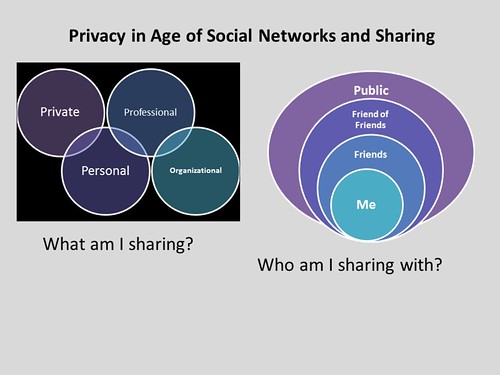
We can no longer think about privacy and sharing as a black and white issue. It isn’t all private or all public – it’s a continuum. Facebook’s new changes (and Google +) gives us a couple of shades of gray. You need to think about what you’re sharing and who you are sharing with.
What Are You Sharing?
Private: This is obvious, but information like your social security number,bank account number, passwords, birthday w/year, or intensely private information that if made public could embarrass you or put you in personal danger.
Personal: In an age of Facebook, many of our close friends and family are using it – and we’re sharing family photos, what we do in our leisure time, hobbies, our location, and all sorts of personal information.
Professional: This content generally includes sharing trade craft, resources, and other items related to professional skill sets.
Organizational: This is when you are sharing information as an official spokesperson for your organization or your organizational persona. Typically, this information about your brand or nonprofit.
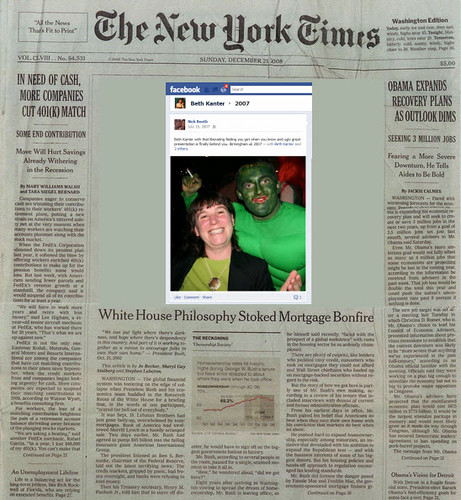
The boundaries between sharing definitions are very blurry. Some people blend the personal with the professional or organization to make the brand more “human” or personalized. Some people are comfortable with this, while others are not. It is a judgement call. For example, a colleague recently said to me, “I have a mix of people who are my friends – my family and friends as well as professionals in my field. I don’t really feel comfortable sharing the fact that I took my kids to Chuck Cheese with all my professional colleagues who are friends with me on Facebook.”
Mari Smith suggested that we should ask ourselves how we would feel if anything we posted on Facebook would show up on the front page of the New York Times, in Google Search, or if her mother would approve.
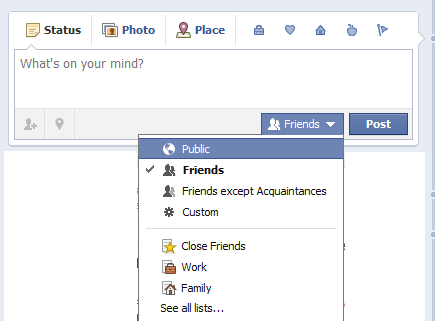
Who Are You Sharing With?
With the changes on Facebook, it is a good idea to get into the habit of training yourself to look who you are sharing with every time you post. You now have the ability to control who you sharing on each status update. If you use a mobile phone app to post, go into your privacy settings and set it what you’re most comfortable with because the mobile apps don’t have the audience selector feature yet. The setting remembers your last setting – so if you will switching between public and friends only postings or to specific lists – you need to pay attention to that icon.
If you haven’t been using the “friends list” feature that allows you to group friends into categories, it might be more useful to you because you can filter the stories you see in News Feed or post an update for specific people They’ve now added “Smart Lists“, these are the lists with the icons. The smart lists include “Acquaintances,”, “Close Friends” and “Restricted” (example: everyone but mom and dad). There are also smart lists for related to geography or what you’ve listed as work.
Sharing in Public
The “public” option for sharing updates means that anyone can see an update that you’ve shared publicly and anyone who has “subscribed” to your updates. The “subscribe” option has to be activated – and the average user on Facebook will probably not want to do this. However, if you use your Facebook profile to connect with professional colleagues or want to promote your organization, you might consider this option. The subscribe option gives you another channel to share public information related to your work or professional life. There is a trade off is that your friends my not want to comment if they notice people they don’t know.
If you’re going to mix it up, Mari suggested that you indicate who you are sharing the update with so people know.
News Ticker
The News Ticker is on the right-hand side when you log into your account. It shows all your friends’ activity in real-time. When you hover over an item on ticker, you can see the full story and join the conversation as it happens. From a privacy standpoint, if you comment on a post on the ticker, be sure you notice what the original privacy settings are on the post. If you aren’t comfortable with who can see the post, don’t comment on it or like it. If you do, a story about your activity will appear on Facebook, including on your timeline (profile), in News Feed and in ticker. Your comments and likes are only visible to people who can see the original post. For example, you might comment on a photo one of your family members posts just to family. A friend of yours who cannot already view the photo will not see a story in ticker about your comment.
Brand Page Changes
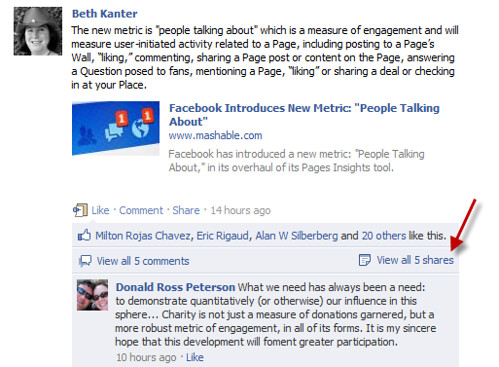
Mari went over all the changes to brand pages, including the most dramatic one: Facebook has nuked the “like” button. People no longer have to “like” or join your Fan Page to comment or like content posted on the wall. The good news is that barriers to interacting on your page have been greatly reduced. It is not as critical to focus on building up the fan base. She mentioned the growing importance of the “share” button – which she described as the equivalent to “retweet” on Twitter. She suggested encouraging more share with a specific call to action on the post itself.
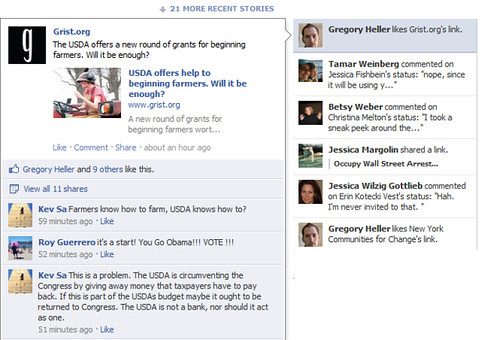
I was watching the ticker and for now, noticing it is my friends activity – and not brand activity – but I can see if my friends have commented, shared, or like content on a brand’s Facebook Page. So, the more you can develop relationships with people and encourage interaction with your content, the more likely they will pay attention to your stuff.
Facebook Rolls Out New Metric: People Talking About
Last night Facebook announced some changes to Insights, the analytics program that we use for tracking Facebook pages, that includes a new metric, “People Talking About.” While Mari didn’t cover this in the webinar, she posted a article from ClickZ worth reading.
“People Talking About This” will be the new Facebook metric, both for page owners and Facebook users. This number will be displayed *publicly* below your total likes (fans)!! More new stats include, “Friends of Fans” and “Total Reach.” Mari points out the important nugget: “We’re moving away from the era of ‘likes;’ we’re now measuring what people discuss on Facebook and a brand’s total reach.”
As Facebook continues to roll out and tweak these changes and as individual users and brands begin to absorb and leverage them, we’re all learning in real time about what will work and what won’t.
Notes from Mari Smith Facebook Changes Webinar: Privacy Settings and A New Metric – People Talking About
Facebook Changes: A Complete Guide – by Mari Smith
View more presentations from Mari Smith
